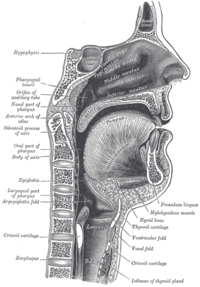
Photo from wikipedia
PURPOSE Voice therapy is the primary treatment for children presenting with benign morphological vocal fold changes. This study examined the number of voice therapy sessions required to meet treatment goals… Click to show full abstract
PURPOSE Voice therapy is the primary treatment for children presenting with benign morphological vocal fold changes. This study examined the number of voice therapy sessions required to meet treatment goals and identified factors that predicted treatment length for pediatric voice patients. METHOD An observational cohort design was employed. Data were extracted from the University of Wisconsin-Madison Voice and Swallow Outcome Database. This study examined 62 children who completed a course of voice therapy with a speech-language pathologist (SLP) addressing dysphonia caused by benign vocal fold lesions. Extracted data included patient demographics, auditory-perceptual assessments, acoustic and aerodynamic voice measures, videostroboscopy ratings, and medical comorbidities. Linear regression was used to identify predictors of number of therapy sessions. RESULTS Patients received an average of 7.5 sessions of voice therapy prior to discharge. Baseline auditory-perceptual assessment of dysphonia (p = .032), phonation threshold pressure (PTP, p = .005), Glottal Function Index (GFI) score (p = .006), and glottic closure pattern (p = .023) were significant predictors of number of voice therapy sessions. These measures, as well as hourglass glottic closure, predicted longer intervention duration. The regression model had an overall r 2 of .62. CONCLUSIONS Pediatric voice therapy addressing benign vocal fold lesions and/or laryngeal edema required an average of 7.54 sessions before voice outcomes were sufficiently improved for discharge. More severe overall SLP ratings of dysphonia, GFI scores, PTP, or hourglass glottic closure pattern significantly predicted increased number of therapy sessions prior to discharge. Future work should determine what other factors affect treatment duration and how the efficiency of pediatric voice therapy can be maximized.
Journal Title: American journal of speech-language pathology
Year Published: 2022
Link to full text (if available)
Share on Social Media: Sign Up to like & get
recommendations!